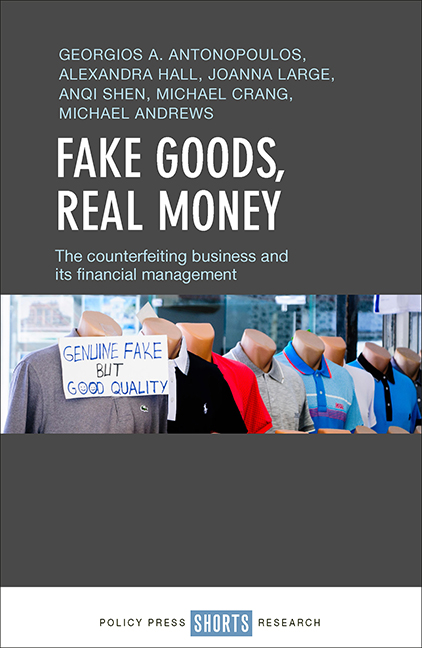Book contents
three - The nature and dynamics of the counterfeiting business
Published online by Cambridge University Press: 12 April 2022
Summary
The counterfeit product supply chain is, like most others, comprising manufacturing, transportation, storage and distribution/retailing. According to statistical data supplied by the World Customs Organization, the US Government and the European Commission, most of the world's counterfeit products originate in China. In 2009, China was the source of US$205 million worth of counterfeit goods seized in the US, which was 79% of the value of all counterfeit products seized that year (UNODC, 2010). In 2014, 81% of all intellectual property (IP)-related seizures in the European Union (EU) came from China and another 8% via Hong Kong (Intellectual Property Office and Foreign & Commonwealth Office, 2015), whereas in 2016, China was identified as the country of provenance making up almost 73% of suspected goods infringing intellectual property rights (IPRs) detained at EU borders in terms of value and 66% in terms of volume (Europol and Office for Harmonisation in the Internal Market, 2016; OECD and EUIPO, 2017). Some have attributed this to Confucian cultures of emulation, but such explanations are not really convincing (Cheung, 2009). According to Lin (2011), the manufacturing of counterfeit goods in China is organised regionally. Specific provinces specialise in the production of certain commodities, which are commonly classified as A-, B- or C-level products depending on their quality and distinguishability from genuine goods (Matthews, 2007; Lin, 2011). There is not a simple line, then, for practitioners of legal/illegal, but rather a differentiated categorisation – as can also be seen in media piracy in ‘notorious markets’ like Nevskii Prospect in St. Petersburg (Sezneva, 2012). It has also been noted that in China, bai-ban goods (literally ‘blank board’, referring to unbranded and unlabelled goods) are produced for further ‘production’ (Shen, 2017; see also Ye, 2000; Guo, 2002). Cultures of copying form a production ‘ecosystem’ where designs are taken from the gongban (‘common bowl’) and where competition drives process innovation to find ways of manufacturing similar but thus counterfeit (shanzhai) products more cheaply.
The movement of counterfeit products from China to the rest of the world is facilitated by complex networks shipping goods via cargo ships, air and online.
- Type
- Chapter
- Information
- Fake Goods, Real MoneyThe Counterfeiting Business and its Financial Management, pp. 15 - 38Publisher: Bristol University PressPrint publication year: 2018



